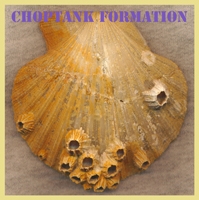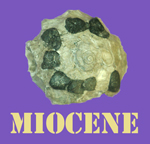The cliffs are constantly undercut by wave action and large chunks and trees regularly collapse onto the beach. Obviously, if you're standing under a cliff when it collapses, you could be in jeopardy. In general, the strata is not well consolidated. Pieces that break off the cliffs are quickly broken apart and any fossils released. Most of the shells on some beaches are fossils with only a few recently dead shells. |
 
This is a view north with cliffs. |
 
The cliffs are very unstable and there are many places where chunks have fall onto the beach and fossils can be collected in the debris. |
The strata dips slightly to the south so that as you go north, the rocks exposed become older. The youngest St. Mary's formation is accessible from Calvert Cliffs State Park, the middle Choptank Formation is accessible from Matoaka Cottages, and the oldest, Calvert Formation, is the northern most and accessible from a town park just south of Chesapeake Beach. Geologists have defined more than 20 zones across the three formations. Some zones have few fossils, others are death assemblages of mollusks.
Here are scenes from Zone 10 in the Calvert Formation. |
 
Various clam shells |
 
Melossia, Astarte, Turritella, Cardium, and Ecphora species can be seen here. |
 
Beach exposure |
 
Closer view of the beach exposure |
 
Even closer view of beach exposure: The most common species in this photo is Glycymeris parlis. Other species include: Cardium laqueatum; Chlamys madisonius; Turretilla plebia; Hydractinia multispinosa; Vermetus virginicus; Melossia sp.; Anadara sp.; Ecphora sp. and Astarte sp. This deposit is a coquina. |
Collecting
Resistant specimens can be collected along the beach, shark and other teeth and some mollusks, but generally as the fossils are washed out of the cliffs, they are destroyed by the waves. As is evident from the photos above, there are places where the layer is a vast death assemblage. The problem is get a piece of it to work with.
I use the following technique to collect the specimens displayed in the pages below:
-
Find a spot where a chunk of cliff has fallen on to the beach or the layer is exposed on the beach in such a way that you can dig a piece out. The beach is public property but anything above high tide is private. Access is limited and I've walked several miles along the beach to get good specimens. Digging in the cliffs requires permission from the land owner and can be dangerous.
-
Secure a piece. I try to get pieces about a 10 inches on a side either by breaking apart a fallen chunk of the cliff or digging in the layer away from the cliff.
-
Wrap the piece in heavy aluminum foil and secure the foil with duct tape. Usually as you collect large chunks, you can collect individual specimens. These I wrap in newspaper or foil for transportation.
-
Back in my laboratory (a table in the basememt), I open the packages and allow the chunks to dry. This can take several weeks. I tried drying a 10 pound chunk in the oven at low temperature but the CO alarm went off and I had to discontinue oven drying.
-
When the chunk is dry, I remove the matrix with dental tools. None of the material from Calvert Cliffs can stand up to careless handling. The fossils are delicate and it doesn't take much to break them into fragments. When there is particularly interesting grouping or really delicate specimens, I leave them with supporting matrix.
-
I stablize a good specimen or group with Elmer's Glue. I mix about one part glue to four parts water and drip it on the specimen with an eyedropper or carefully immerse the specimen. Sometimes I treat a specimen twice. Once the glue is dry, the specimen is stable and can be handled carefully.
-
The specimens that I recover this way are generally larger than 1/4 inch. I shift the broken shells and sand to recover specimens smaller than 1/4 inch. This requires a microscope and can be time consuming and tedius but yields a number of fossils that would otherwise be lost including foraminifers, octocods, very small clams and snails, small drum fish teeth and, a couple of times, tiny pearls and insect parts.
Click on an image below to see fossils from each formation. |
 |
 |
 |
Browsing
As with images on other fossil pages, rolling over a thumbnail displays a larger image. Click on the name of the specimen to see additional images and descriptions. The ruler in the images is in 1/16 inch increments.
When you see small specimens mounted on red inside a circle, the circle is 9/16 inch wide. The drawings are from the 1904 Maryland Geological Survey Miocene Plates or the survey's 2002 CD, Miocene Fossils of Maryland.
Additional Information
Here are websites with information about the Miocene deposits in Maryland:
|
| |
|
|
|
|

















